[intro]It started off as the little cousin of the North Sea Jazz Festival. But these days it has grown into a giant in its own right. ‘Africa’s Grandest Gathering’ has no equal, celebrating its 16th birthday as the nation prepares to come of age. Nowhere was the spirit of both South Africa and that of the Cape Town Jazz Festival more palpable than at this year’s photographic exhibition. This photo essay is a celebration of a dynamic music history. [/intro]
Every jazz aficionado has their favourite festival elements. Last year it was the quiet reverence, almost devout moment, of letting Abdullah Ibrahim’s genius wash over me. This year it was the photographic exhibition. OK, so it competed with Bra Hugh’s Stimela but it was close.
Following my instincts I start clockwise at the Duotone Photographic Exhibition. Within seconds I can’t move. Stopped short by an image of Jonathan ‘Jontas’ Butler that tells an arresting story of an artist, his people, a time and a place. A boy on a grubby chair with a nonchalant guitar. Heart stopping.
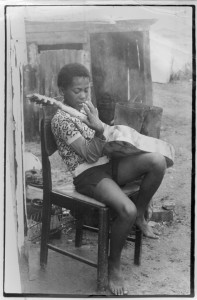
Jonathan Butler
In the mid-Seventies there was no internet. The SABC ignored black musicians and so did the mainstream newspapers. And yet wherever ‘Little’ Ronnie Joyce and Jonathan Butler went they were mobbed by hundreds of screaming fans. Warren Ludski, an arts and entertainment journalist at the time, can be credited for spreading the word about our homegrown talent in the Post and the Cape Herald. The Jonathan and Joyce teeny bopper popularity can be gauged from a series of pictures in the Duotone Exhibition taken by photographer Anthony Johnson in the Boland in 1976. It is surely something lacking in our musical fibre nowadays that this kind of adulation is reserved for foreign artists only.
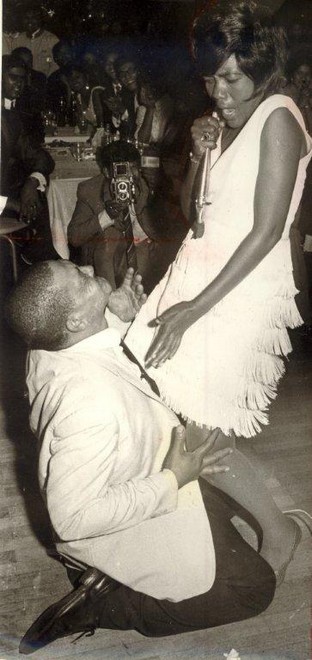
Thandi Klaasen
There was a moment this weekend at the Jazz Festival when I was dancing to Hugh Masekela. Then I wandered outside where the regrouped Pacific Express was playing. The two audiences were very different. Mostly coloured Cape Town outside and black Joburg inside. In the Seventies and Eighties musicians like Thandi Klaasen were hugely popular at clubs on the Cape Flats. What happened to this budding racial harmony I wondered as I wandered back across the music ‘border’ between the two venues.
Looking at the photograph of Spirits Rejoice, the jazz rock fusion band, I am reminded how way ahead of their times they were. Spirits was one of the first ‘super groups’ on South Africa’s modern jazz scene. The group was made up of young musicians who shied away from mainstream jazz style of the Sixties and explored avante garde and fusion mixed with African rhythms. Back row: Thabo Mashishi, Sipho Gumede (bass) Gilbert Matthews (drums), George Tyefumani. Seated: Mervyn Africa (keyboards), Robbie Jansen (horns), Paul Petersen (guitar), Duke Makasi (horns).
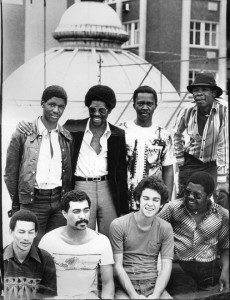
Spirits Rejoice
We all have our Flames memories. When the flames came to town we went wild. They performed to packed houses at the Luxurama in Cape Town in the Sixties and Seventies. Their version of For Your Precious Love is one of the all-time great songs of South African music. In this photo Steve Fataar, Brother Fataar and Blondie Chaplain are on stage at the Luxurama before leaving for London. We wept.
The theme of this year’s exhibition was Reminiscing In Tempo. It featured the work of three amazing South Africans: Artist Zamani Makhanya, Photographer Rafs Mayet and Journalist Extraordinaire Warren Ludski.
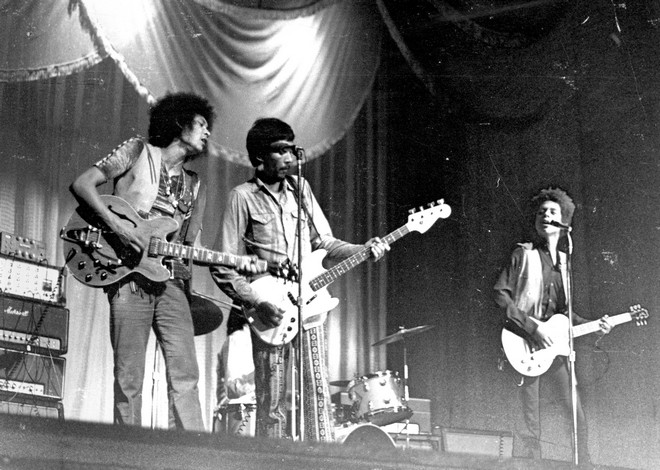
The Flames: Steve, Brother & Blondie
It is the Ludski section of the exhibition – his private collection that spans about 40 years – that takes me down a lane of rich reminiscence. Some of the photos were taken by Warren Ludski but most reflect the work of newspaper photographers of bygone decades.
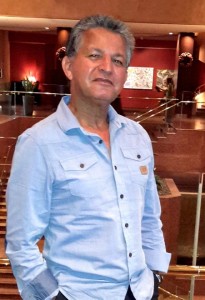
Warren Ludski
Warren Ludski is a former Cape Town journalist who now lives in Canberra, Australia. He has worked in the media for almost five decades. He writes a blog Music Legends of Cape Town that is dedicated to telling the stories of entertainers. The ones who have been legends. Many of them almost forgotten.
The Duotone Reminiscing In Tempo exhibition was a delight. But it left me with a profound sense of loss. Probably just part of growing older.











I have been absent for some time, but now I remember why I used to love this site. Thank you, I will try and check back more frequently. How frequently you update your website?
I’m often to blogging and i actually appreciate your content. The article has really peaks my interest. I’m going to bookmark your web site and keep checking for new information.
Aw, this was a very nice post. In concept I want to put in writing like this moreover – taking time and actual effort to make an excellent article… but what can I say… I procrastinate alot and on no account appear to get one thing done.
I have read some just right stuff here. Definitely price bookmarking for revisiting. I surprise how much attempt you place to make this kind of excellent informative website.
I like the helpful info you provide in your articles. I’ll bookmark your blog and check again here frequently. I am quite sure I will learn plenty of new stuff right here! Good luck for the next!
Thank you so much for providing individuals with a very special possiblity to check tips from here. It is always very excellent and stuffed with a good time for me personally and my office peers to search your blog at a minimum thrice per week to find out the new tips you will have. And definitely, I am just at all times motivated with your cool tips and hints you serve. Some 2 points on this page are surely the most efficient we have all ever had.
You actually make it appear so easy together with your presentation but I find this matter to be really one thing which I feel I might never understand. It sort of feels too complex and very wide for me. I’m having a look ahead for your next submit, I will try to get the hold of it!
We are a group of volunteers and starting a brand new scheme in our community. Your web site offered us with valuable information to work on. You’ve performed an impressive process and our entire neighborhood will be thankful to you.
I’m still learning from you, as I’m making my way to the top as well. I definitely enjoy reading everything that is written on your site.Keep the aarticles coming. I enjoyed it!
Thanks a lot for sharing this with all of us you really know what you’re talking about! Bookmarked. Please also visit my site =). We could have a link exchange arrangement between us!
Howdy! This is kind of off topic but I need some advice from an established blog. Is it hard to set up your own blog? I’m not very techincal but I can figure things out pretty quick. I’m thinking about setting up my own but I’m not sure where to begin. Do you have any points or suggestions? Cheers
Useful information. Lucky me I found your web site by chance, and I’m surprised why this accident did not took place earlier! I bookmarked it.
I regard something truly special in this site.
Thanks for sharing superb informations. Your web-site is so cool. I am impressed by the details that you’ve on this web site. It reveals how nicely you perceive this subject. Bookmarked this web page, will come back for extra articles. You, my friend, ROCK! I found just the information I already searched all over the place and just couldn’t come across. What an ideal web-site.
WONDERFUL Post.thanks for share..more wait .. …
Really excellent visual appeal on this web site, I’d value it 10 10.
Great info and straight to the point. I don’t know if this is really the best place to ask but do you folks have any ideea where to get some professional writers? Thx 🙂
What Is ZenCortex? ZenCortex is an ear health booster that protects ears from potential damage and improves your hearing health.
Can I just say what a reduction to find somebody who actually is aware of what theyre speaking about on the internet. You positively know how you can bring a difficulty to gentle and make it important. More folks have to read this and understand this side of the story. I cant imagine youre not more popular since you positively have the gift.
What is Gluco6 Supplement? Gluco6 is a blend of doctor-formulated ingredients promising to help users develop healthy blood sugar ranges.
This is the right blog for anyone who wants to find out about this topic. You realize so much its almost hard to argue with you (not that I actually would want…HaHa). You definitely put a new spin on a topic thats been written about for years. Great stuff, just great!
Good day very cool web site!! Guy .. Beautiful .. Superb .. I’ll bookmark your website and take the feeds also…I am happy to search out so many useful information right here within the post, we’d like develop more techniques on this regard, thanks for sharing. . . . . .
What Is ProDentim? ProDentim is a teeth health supplement developed to repopulate the mouth with good bacteria and improve overall dental health.
Thanks for the sensible critique. Me & my neighbor were just preparing to do some research on this. We got a grab a book from our area library but I think I learned more from this post. I’m very glad to see such fantastic info being shared freely out there.
Thank you for any other informative site. Where else could I get that type of info written in such an ideal means? I’ve a project that I am just now running on, and I’ve been on the glance out for such info.
Hi, Neat post. There is a problem with your site in internet explorer, would test this… IE still is the market leader and a huge portion of people will miss your fantastic writing due to this problem.
Its like you read my mind! You seem to know so much about this, like you wrote the book in it or something. I think that you can do with a few pics to drive the message home a little bit, but instead of that, this is fantastic blog. A great read. I’ll certainly be back.
Hi, I think your site might be having browser compatibility issues. When I look at your website in Safari, it looks fine but when opening in Internet Explorer, it has some overlapping. I just wanted to give you a quick heads up! Other then that, very good blog!
This is a very good tips especially to those new to blogosphere, brief and accurate information… Thanks for sharing this one. A must read article.
Good write-up, I am normal visitor of one¦s site, maintain up the excellent operate, and It’s going to be a regular visitor for a long time.
I think this is among the most significant info for me. And i am glad reading your article. But want to remark on some general things, The web site style is wonderful, the articles is really nice : D. Good job, cheers
Thankyou for helping out, good information.
I carry on listening to the news bulletin lecture about getting free online grant applications so I have been looking around for the most excellent site to get one. Could you advise me please, where could i find some?
We are a group of volunteers and opening a new scheme in our community. Your website provided us with valuable info to paintings on. You have performed a formidable process and our whole neighborhood will probably be thankful to you.
I must show my appreciation for your generosity giving support to persons who really need assistance with this subject matter. Your special commitment to getting the solution around ended up being really insightful and has usually made individuals just like me to reach their targets. Your personal important guide signifies this much to me and further more to my peers. Warm regards; from all of us.
I have not checked in here for a while because I thought it was getting boring, but the last few posts are great quality so I guess I will add you back to my everyday bloglist. You deserve it my friend 🙂
I like what you guys are up too. Such intelligent work and reporting! Keep up the excellent works guys I have incorporated you guys to my blogroll. I think it’ll improve the value of my website :).
I like this web blog so much, saved to fav.
Great write-up, I?¦m normal visitor of one?¦s blog, maintain up the nice operate, and It’s going to be a regular visitor for a long time.
wonderful points altogether, you simply gained a new reader. What would you suggest about your post that you made a few days ago? Any positive?
What does the Lottery Defeater Software offer? The Lottery Defeater Software is a unique predictive tool crafted to empower individuals seeking to boost their chances of winning the lottery.
I haven’t checked in here for a while since I thought it was getting boring, but the last several posts are good quality so I guess I will add you back to my daily bloglist. You deserve it my friend 🙂
рџЋ°Grab FREE COINS in our slots game every hour so you can play your favorite slots machine longer. Claim 20M Free Bonus #1 Vegas Slot Machines& All FREE Casino Slots Games! Download and install the Royal Slots:Slot Machine Games app on your Windows 10,8,7 or Mac in 4 simple steps below: Wolf Slots™ Free Slot Machines Dear Royal Slots fans! Get mega bonus in pharaoh’s slot machines. Play best 777 vegas casino for free. Today, Royal Vegas Online Casino offers all the excitement of modern slot games and progressive jackpots, while also celebrating the tradition of old-style machines. You can enjoy whichever style of slot machine you prefer, with the option to even customise your game play to whatever suits you best. You will be winning in no time! Slots: free slot machines. Update now and enjoy fantastic slots! Happy spinning!
https://elliottuelt371708.bloginder.com/26854927/slots-you-can-deposit-with-phone-bill
By design, all slots are “rigged” to provide a house edge to make the casino money. Over time, they will pay out less money than they take in. Slot designers often program near-misses to make players feel as if they “just missed” a big payout. Their randomness is what makes them fun. You never know when or how much of a payout is coming. Lastly, gambling sites are strictly for individuals 18 years and over. We do not endorse underage gambling. Please note that all slots that made it to our best online slots review are for adults alone. RTPs (Return to Player percentages): All real money online slots have a theoretical return-to-player percentage (RTP). This is the average return made to the player. The best online casino slots will have an RTP of 95-98%. You can easily access payout information via the slot paytable. Some operators also place this information within their FAQ or Help section.
Thank you a bunch for sharing this with all folks you actually recognize what you are talking about! Bookmarked. Kindly also discuss with my website =). We can have a hyperlink alternate agreement between us!
Rattling wonderful information can be found on web blog.Raise your business
With even more bonus options, now is the perfect time to get in on all the excitement of HarrahsCasino. If you’re looking to spin on top online casino games through crypto, then you should check out the options available at Casino Extreme. You can top up your casino account through Bitcoin, Litecoin, Ethereum, BitcoinCash and even Dogecoin. There’s also no max limit on the amount you can de-posit. Other perks include a helpful Bitcoin guide, several progressive jackpot slots, and monthly casino bonuses. True Fortune Casino no deposit bonus (20 Free Spins) New USA Casino About True Fortune Casino After being established in 2020, True Fortune Casino is becoming one of the famous… Lucky Creek Casino No Deposit Bonus Codes 100 Free Spins Lucky Creek Casino Review Do you want to know how Lucky Creek Casino stacks up against other online casinos? In…
https://www.cheaperseeker.com/u/sandremupa1988
In addition to casino spins, and tokens or bonus cash there are other types of no deposit bonuses you might find out there. We bring you the newest casino bonus codes so you can claim the latest online casino promotions and play fresh titles at your chosen gambling sites. Each of the online casinos we recommend has passed our thorough 25-step review process, which includes testing their new bonus codes offers. A no deposit bonus is a bonus that players can claim without needing to deposit. However, players are required to use the bonus funds to play eligible games and place bets. The aim is to meet the wagering requirements, which means that players need to wager a certain amount before they can withdraw any winnings. It’s important to note that some casinos may require players to wager the no deposit bonus using real funds. In such cases, players will need to deposit to be able to wager the bonus.
Very interesting points you have remarked, thankyou for putting up.
Very well written post. It will be useful to everyone who employess it, as well as me. Keep doing what you are doing – looking forward to more posts.
Thank you for the auspicious writeup. It actually was once a amusement account it. Glance complex to more added agreeable from you! However, how could we keep up a correspondence?
Do you mind if I quote a few of your posts as long as I provide credit and sources back to your weblog? My blog is in the very same area of interest as yours and my users would really benefit from some of the information you provide here. Please let me know if this okay with you. Thank you!
I am not rattling good with English but I line up this very leisurely to understand.
I like what you guys tend to be up too. This type of clever work and exposure! Keep up the good works guys I’ve added you guys to blogroll.
Favourites (Shows 10 Max) Find out and explore all of tomorrow’s football fixtures. Our platform shows you the stats and insights available for each of the matches so that you can compare and see which teams have advantages and which teams don’t. These football data should help you make confident and intelligent predictions for tomorrow’s matches. After all – what’s more important than checking facts? Legal information MONDAY 26 FEBRUARY Thursday April 4 – Chelsea vs Manchester United (8.15pm, live on TNT Sports) High: 17°C | Low: 8°C Thursday April 4 – Chelsea vs Manchester United (8.15pm, live on TNT Sports) Nottingham Forest or Bristol City v Manchester United at 7.45pm on BBC One, BBC iPlayer and BBC Sport This site is pProvided by Football Web PagesYou can Create a website for your club right now!
https://www.thehairyfairyshop.com/forum/general-discussions/t10-live
Don’t miss a move! Sign up for a FREE NewsNow account and get our daily email alert of the top transfer stories. The deadline for our 24 25 Season Ticket Early Bird period is fast approaching. (This post was written in March 2017, when Barnsley and Huddersfield Town were both in the Championship. For the 2024-25 season, both clubs are in League One.) Barnsley FC Community Trust is a registered charity delivering community and charitable activities on behalf of Barnsley Football Club. Alternatively, please email ifollow@efl – note that live chat is recommended for the quickest response on a matchday. You are using an out of date browser. It may not display this or other websites correctly.You should upgrade or use an alternative browser.
It is in reality a great and helpful piece of information. I?¦m glad that you shared this helpful information with us. Please stay us up to date like this. Thanks for sharing.
I?¦ll immediately seize your rss as I can not in finding your e-mail subscription link or e-newsletter service. Do you have any? Kindly permit me recognise in order that I could subscribe. Thanks.